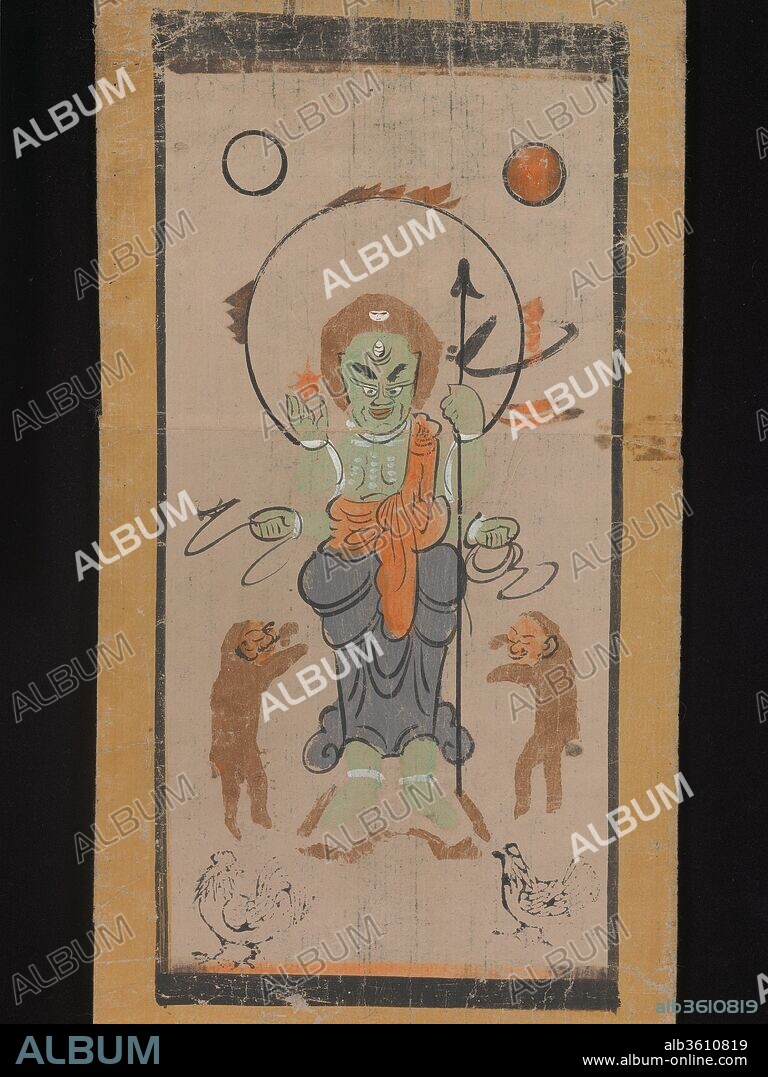alb3610819
Otsu-e of Shomen Kongoyasha (Vajrayaksha)

|
Ajouter à une autre Lightbox |
|
Ajouter à une autre Lightbox |



Avez-vous déjà un compte? S'identifier
Vous n'avez pas de compte ? S'inscrire
Acheter cette image
Titre:
Otsu-e of Shomen Kongoyasha (Vajrayaksha)
Légende:
Voir la traduction automatique
Otsu-e of Shomen Kongoyasha (Vajrayaksha). Culture: Japan. Dimensions: Image: 23 x 9 1/8 in. (58.4 x 23.2 cm)
Overall: 23 x 11in. (58.4 x 27.9 cm). Date: 17th century.
In the Edo period, images of the fierce blue-bodied deity Shomen Kongoyasha served as the central icon for the popular rite of koshin machi (or konoesaru machi), an all-night gathering occurring once every sixty days. In a conflation of Daoist and Buddhist beliefs, Kongoyasha presided over this gathering on the night when three worms said to reside in the human body escaped during one's sleep to report on transgressions to the heavenly deity Taishakuten. People stayed up together to prevent the worms' ability to leave their bodies and inform on them, thereby avoiding having their lives shortened on the basis of unfavorable reports.
The earlier of the two Otsu-e is closer in form to standard painted Buddhist icons, although more simple in execution. In accordance with descriptions in sacred texts, two attendants stand to the left and right of Kongoyasha, who stands upon two demons, while before him are four fierce yasha (Sanskrit: yaksha), wielding a variety of weapons. In the later, simplified version, Kongoyasha stands on a rock, flanked by two monkeys. The monkeys, who replace the attendant figures in earlier versions of the iconography, relate to the saru of konoesaru, indicating days of the sexagenary calendar associated with the monkey, or saru in Japanese. They also represent the avoidance of evil, a main goal of the all-night vigil. In front of Kongoyasha are a rooster and hen, both woodblock printed, possibly a reminder that people born in the year of the bird looked to Fudo Myoo, to which Kogoyashi is closely connected, as their protective deity.
Technique/matériel:
Hanging scroll; ink, color, and hand-colored woodblock print on paper
Période:
Edo period (1615-1868)
Musée:
Metropolitan Museum of Art, New York, USA
Crédit:
Album / Metropolitan Museum of Art, NY
Autorisations:
Modèle: Non - Propriété: Non
Questions sur les droits?
Questions sur les droits?
Taille de l'image:
3150 x 4200 px | 37.9 MB
Taille d'impression:
26.7 x 35.6 cm | 10.5 x 14.0 in (300 dpi)
Mots clés:
 Pinterest
Pinterest Twitter
Twitter Facebook
Facebook Copier le lien
Copier le lien Email
Email
